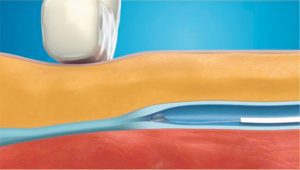 Minimally Invasive vein therapies have revolutionized treatment of patients with venous and lymphatic disorders.
Minimally Invasive vein therapies have revolutionized treatment of patients with venous and lymphatic disorders.
Percutaneous procedures performed only through needle and catheter access have been developed to resolve varicose veins of any size and improve outcomes in patients with leg swelling and lymphedema. The common procedures to close the saphenous vein, the root cause of venous insufficiency, have up until now used thermal or heat closure of the vein. These procedures, namely EndoVenous Laser Ablation and Radiofrequency Ablation, carry increased discomfort during and after the procedure. More recently Venaseal , a cyanoacrylate adhesive, has been developed to close these veins without the use of high temperature. Venaseal is now available to Villages patients through the Central Florida Vein and Vascular Center.
Many randomized trials have been published comparing Venaseal to thermal techniques and the results are impressive. Venaseal closure of the refluxing veins is as effective as thermal techniques, without the negative side effects. The side effects of thermal ablation include increased pain during and after the procedure, increased bruising and trauma to the surrounding tissues. While not problematic, these side effects make Venaseal a more attractive option for vein ablation. Thermal ablations require that the patient wear compression hose after the procedure, a difficult hardship for patients living in Florida.
Four advantages of Venaseal compared to thermal ablation:
1. Only one needle stick. Thermal ablation procedures require tumescent anesthesia to be injected along the course of the vein to help with pain control and to absorb the heat produced. This anesthesia needs to be introduced up the leg with separate injections. While usually very well tolerated with minimal discomfort, it represents an extra part of the procedure not needed during Venaseal ablation. Pain and quality of life scores related to the procedure and immediate recovery were better with Venaseal.
2. Decreased bruising in the post procedure period
3. Reduced recovery time and sooner return to baseline activity/work
4. No post procedure compression stockings needed.
The Venaseal procedure: Patients are first
evaluated with a venous reflux ultrasound. This shows the deep veins and the absence of recent or longstanding thrombosis. Once determined that saphenous reflux is the cause of the patient’s varicose veins, pain, or swelling the patient is prepared for the office based procedure. On the day of the procedure, a repeat ultrasound is
performed to plan where to deposit the adhesive in the vein. Once the procedure is planned, a sterile field is established and ultrasound guidance is used to access the vein being treated. Once a catheter is placed in the appropriate location, a Venaseal adhesive delivery catheter is utilized to deliver small droplets of the adhesive. Pressure is applied for three minutes, the catheter is further withdrawn, and the next segment is treated. The entire vein is treated as planned. When complete, only a small adhesive strip is placed at the entry site. The procedure is completely ambulatory and performed in the office.
The Central Florida Vein and Vascular Center is proud to be the State of Florida’s leading experts in Venaseal therapy. The physicians are not only specialty trained and certified in the treatment of patients with venous and lymphatic disorders, they are recognized as the most experienced practitioners in Venaseal therapy. Dr. Rafael Quinones recently relocated from Sarasota, FL and has quickly resumed his expert utilization of Venaseal therapy. Dr. Quinones and Dr. Wrobleski are both physicians in the Villages office and combined continue to lead the vein care community not only in Vensaseal therapy, but all modalities to treat venous and lymphatic disorders.
Center Florida Vein and Vascular Center
(352) 562-0078 . www.cfvein.com
13953 NE 86th Terrace, Unit 101
Lady Lake, FL 32159
MOST PROCEDURES ARE
COVERED BY INSURANCE
Convenient Golf Cart Path Access
 Central Florida Health and Wellness Magazine Health and Wellness Articles of the Villages
Central Florida Health and Wellness Magazine Health and Wellness Articles of the Villages


